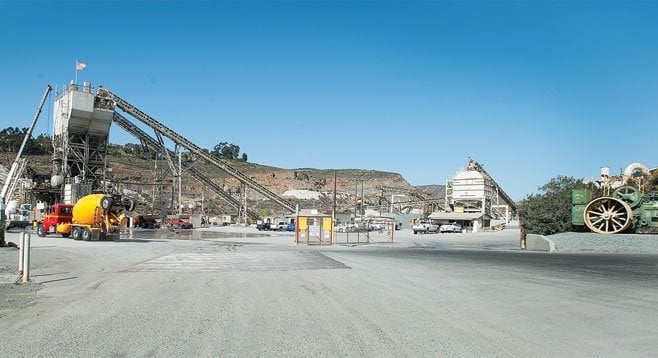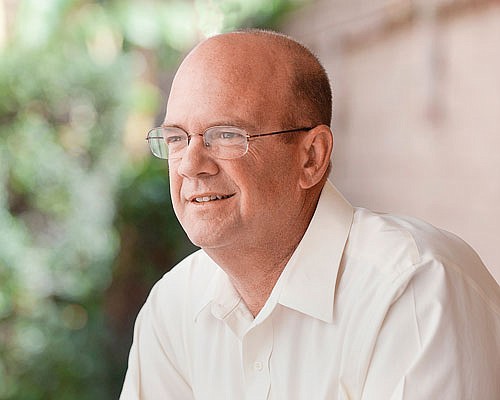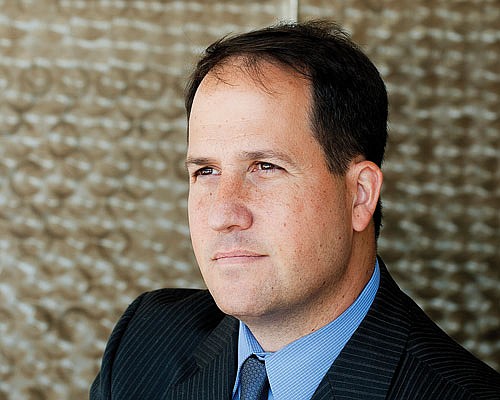 Facebook
Facebook
 X
X
 Instagram
Instagram
 TikTok
TikTok
 Youtube
Youtube

Residents of Grantville and Allied Gardens and those living along Mission Gorge Road can agree on one thing: change is coming to the area. And it will come acres at a time, in the form of mixed-use, high-density development projects.
Enticed by the proximity to downtown, major freeways, and the trolley, developers have eyed Grantville and the strip of land along Mission Gorge Road northeast of Grantville for years. Their plans stalled, however, as the economy sputtered.
City planners also saw the area as the perfect place to absorb future growth. In a proposed community plan amendment, planners identified the Navajo community — Allied Gardens, Del Cerro, Grantville, and San Carlos — as “prime for neighborhood revitalization with a more lively mix of employment, commercial, higher density residential, and civic uses.”
Now, as the economy gains ground, builders are dusting off project designs, intent on finding out just how prime the land is.
In coming years, anywhere from 8000 to 11,000 new residential units will be built. Some projects are in the beginning stages. Among the proposals is the Shawnee project, a mixed-use development with over 1000 units on 23 acres just steps from the San Diego River, along Mission Gorge Road near Old Cliffs Road. Much of the property is currently a yard for vehicles, equipment, and storage bins. The Shawnee project is a stone’s throw away from a proposed 444-unit condominium complex to the south and a proposed 2000-unit mixed-use development to the north, on land owned by Superior Ready Mix concrete company, which operates a quarry farther down Mission Gorge Road.
Residents worry that large-scale development projects will ravage the crumbling infrastructure, bring more traffic to busy streets, and exhaust all efforts by the community to obtain more park space.
“Community character evolves over time, which ultimately means change is coming,” says Anthony Wagner, a member of the Navajo Community Planners, Inc., and the Allied Gardens Community Council. “Developers are eyeing Allied Gardens and Grantville because it is one of the last neighborhoods left in San Diego for them to capitalize on financially viable, high-density multifamily housing. It’s not necessarily bad, but to me it is about finding common ground between residents and developers.”
Park space is one issue on which residents such as Wagner have been unable to find common ground with developers.
Residents of Allied Gardens and Grantville “cringe at the prospect of creating a hodgepodge of mixed-use development,” Wagner says. “Developers are penciling projects that don’t include enough park space. They’re hedging their bets, buying park-mitigation credits from the City to allow them dispensation from proper park-space development. Developing the land with high-density housing is exponentially more profitable than green space.”
According to the minutes of the Navajo Community Planners January meeting, “5.5 acres of park land are required for the 1,023-unit” Shawnee housing development. The builders, Urban Housing Partners, have proposed setting aside 2.57 acres “for open space, and in-lieu fees will be paid to offset the remaining requirement of approximately 3 acres.”
Residents consider development projects among the most important issues in this year’s election of the District Seven councilmember. Candidates Scott Sherman and Mat Kostrinsky, both new to seeking political office, are vying for the seat. (The incumbent, Marti Emerald, announced that she will run for the District Nine seat.)
Dale Peterson represents the San Carlos neighborhood on Navajo Community Planners, Inc. He stresses the importance of the coming election. “Developers are looking to introduce dense housing projects within single-family-home communities. This is my most salient concern, and District Seven residents should be very interested that neighborhood streets, parks, and community resources will be stretched beyond reasonable and original intended uses. As an example, traffic plans basically say, ‘We will put a few more lights on some streets, look at establishing a local shuttle service, and add some bike lanes.’ There is not a real plan for traffic mitigation.”
In recent months, the candidates have come out on opposing sides of many issues. One thing they agree on is the importance of attracting smart projects to the Navajo community.
“Each project should be evaluated on its merit. There is a process for that, and it involves the community,” says Sherman, the president of a local insurance firm, 5th Avenue Insurance. “It’s the community that has to be involved and benefit from any developments. Contractors must be held accountable for the necessary infrastructure.”

Sherman says he supports smart development and stresses the need for developer impact fees to build new parks. But according to recent campaign finance statements, Sherman has received dozens of donations from the building industry, including a total of $7600 in 2011 from principals and employees of developers H.G. Fenton, Sudberry Properties, McMillin, and Urban Housing Partners and from Superior Ready Mix. The Building Industry of San Diego County has endorsed him. Some fear, if elected, Sherman will be in the back pocket of developers. Sherman rejects that accusation.
“I don’t believe it is responsible to be blindly pro-development or anti-development,” says Sherman.

Mat Kostrinsky, a former aide to Senator Dianne Feinstein and currently an advocate for UDW–Homecare Providers Union, believes the right solution will weigh the proposals from developers and the concerns from residents. “I can’t speak for why certain developers and their attorneys and consultants contribute immediately to another candidate without first taking the time to come to the table to discuss these issues with me,” he says. “The ones that did meet with me without personal agendas do in fact support me.”
Anthony Wagner plans to keep his eye on upcoming development and is eager to hear more from both candidates.
“The new councilmember will be tasked with stemming the tidewaters but allowing a stream,” says Wagner. “I think community character in Allied Gardens and Grantville is at stake in this election cycle. The new councilmember has an opportunity to create fair, responsible, and equitable change.”


Residents of Grantville and Allied Gardens and those living along Mission Gorge Road can agree on one thing: change is coming to the area. And it will come acres at a time, in the form of mixed-use, high-density development projects.
Enticed by the proximity to downtown, major freeways, and the trolley, developers have eyed Grantville and the strip of land along Mission Gorge Road northeast of Grantville for years. Their plans stalled, however, as the economy sputtered.
City planners also saw the area as the perfect place to absorb future growth. In a proposed community plan amendment, planners identified the Navajo community — Allied Gardens, Del Cerro, Grantville, and San Carlos — as “prime for neighborhood revitalization with a more lively mix of employment, commercial, higher density residential, and civic uses.”
Now, as the economy gains ground, builders are dusting off project designs, intent on finding out just how prime the land is.
In coming years, anywhere from 8000 to 11,000 new residential units will be built. Some projects are in the beginning stages. Among the proposals is the Shawnee project, a mixed-use development with over 1000 units on 23 acres just steps from the San Diego River, along Mission Gorge Road near Old Cliffs Road. Much of the property is currently a yard for vehicles, equipment, and storage bins. The Shawnee project is a stone’s throw away from a proposed 444-unit condominium complex to the south and a proposed 2000-unit mixed-use development to the north, on land owned by Superior Ready Mix concrete company, which operates a quarry farther down Mission Gorge Road.
Residents worry that large-scale development projects will ravage the crumbling infrastructure, bring more traffic to busy streets, and exhaust all efforts by the community to obtain more park space.
“Community character evolves over time, which ultimately means change is coming,” says Anthony Wagner, a member of the Navajo Community Planners, Inc., and the Allied Gardens Community Council. “Developers are eyeing Allied Gardens and Grantville because it is one of the last neighborhoods left in San Diego for them to capitalize on financially viable, high-density multifamily housing. It’s not necessarily bad, but to me it is about finding common ground between residents and developers.”
Park space is one issue on which residents such as Wagner have been unable to find common ground with developers.
Residents of Allied Gardens and Grantville “cringe at the prospect of creating a hodgepodge of mixed-use development,” Wagner says. “Developers are penciling projects that don’t include enough park space. They’re hedging their bets, buying park-mitigation credits from the City to allow them dispensation from proper park-space development. Developing the land with high-density housing is exponentially more profitable than green space.”
According to the minutes of the Navajo Community Planners January meeting, “5.5 acres of park land are required for the 1,023-unit” Shawnee housing development. The builders, Urban Housing Partners, have proposed setting aside 2.57 acres “for open space, and in-lieu fees will be paid to offset the remaining requirement of approximately 3 acres.”
Residents consider development projects among the most important issues in this year’s election of the District Seven councilmember. Candidates Scott Sherman and Mat Kostrinsky, both new to seeking political office, are vying for the seat. (The incumbent, Marti Emerald, announced that she will run for the District Nine seat.)
Dale Peterson represents the San Carlos neighborhood on Navajo Community Planners, Inc. He stresses the importance of the coming election. “Developers are looking to introduce dense housing projects within single-family-home communities. This is my most salient concern, and District Seven residents should be very interested that neighborhood streets, parks, and community resources will be stretched beyond reasonable and original intended uses. As an example, traffic plans basically say, ‘We will put a few more lights on some streets, look at establishing a local shuttle service, and add some bike lanes.’ There is not a real plan for traffic mitigation.”
In recent months, the candidates have come out on opposing sides of many issues. One thing they agree on is the importance of attracting smart projects to the Navajo community.
“Each project should be evaluated on its merit. There is a process for that, and it involves the community,” says Sherman, the president of a local insurance firm, 5th Avenue Insurance. “It’s the community that has to be involved and benefit from any developments. Contractors must be held accountable for the necessary infrastructure.”

Sherman says he supports smart development and stresses the need for developer impact fees to build new parks. But according to recent campaign finance statements, Sherman has received dozens of donations from the building industry, including a total of $7600 in 2011 from principals and employees of developers H.G. Fenton, Sudberry Properties, McMillin, and Urban Housing Partners and from Superior Ready Mix. The Building Industry of San Diego County has endorsed him. Some fear, if elected, Sherman will be in the back pocket of developers. Sherman rejects that accusation.
“I don’t believe it is responsible to be blindly pro-development or anti-development,” says Sherman.

Mat Kostrinsky, a former aide to Senator Dianne Feinstein and currently an advocate for UDW–Homecare Providers Union, believes the right solution will weigh the proposals from developers and the concerns from residents. “I can’t speak for why certain developers and their attorneys and consultants contribute immediately to another candidate without first taking the time to come to the table to discuss these issues with me,” he says. “The ones that did meet with me without personal agendas do in fact support me.”
Anthony Wagner plans to keep his eye on upcoming development and is eager to hear more from both candidates.
“The new councilmember will be tasked with stemming the tidewaters but allowing a stream,” says Wagner. “I think community character in Allied Gardens and Grantville is at stake in this election cycle. The new councilmember has an opportunity to create fair, responsible, and equitable change.”
Comments